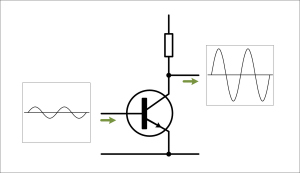
In a class A amplifier the input signal is amplified by one single circuit (transistor). The output signal is the exact image of the input signal. This technology is used today mostly for preamplifiers and other small signal amplification.

The Class A technology is relatively simple. The amplifier circuit must be biased to make sure it works on the linear part of the transfer characteristic curve of the circuit to ensure minimal distortion. This means that the device is never 'off' and it guaranties a good high frequency performance and feedback loop stability. The Class A amplifier is relatively inefficient but can deliver very good sound quality. The efficiency is about 50%.
In the Class AB amplifier one circuit amplifies only half of the wave form. Two circuits as a complementary pair have to work exactly together for the entire wave form. Each half of the complementary pair is amplifying the opposite half of the waveform. The two half wave forms are then recombined. Class AB amplifiers are very efficient.

Both 'half' circuits are biased (as Class A) to avoid small discontinuities at the recombining stage (crossover distortion). But still the possibility for crossover distortion is never completely eliminated. To further improve the linearity, each 'half' circuit also conducts a very small amount of the opposite wave form. This way the overlapping area is smoothed out. The efficiency is about 75%. Class AB is still the most common design for audio power amplifiers.
The Class D amplifier converts the input signal is a sequence of pulses, similar to a digital wave form but it is still an analogue signal. The length of the pulses is directly proportional to the signal amplitude.
The higher the amplitude is at a certain moment the longer is the pulse. To ensure a usable working condition the frequency of the pulses must be at least ten times higher as the upper frequency limit of the analogue audio signal.

The pulses are amplified by switing devices (e.g. MOSFET circuits) that are very efficient. At the output stage the amplified pulses are smoothed out by a low-pass filter to reproduce the original wave form as much as possible. A disadvantage is that the output filter decreases the damping factor (especially important for the use with subwoofers). The efficiency of Class D amplifiers is very high, up to 90% and more.
A Class G amplifier uses several power rails for different voltage ranges within the amplified signal. This way the efficiency of the output transistor can be improved drastically by minimizing the wasted power at the output transistor. For smaller signals or smaller signal parts a smaller voltage is used and the voltage is switched to the next higher rail if needed.

The Class H amplifier doesn't use several voltage rails but a variable power supply rail by modulating the power supply characteristics with the input audio signal. Only the needed voltage is supplied to the output transistor and it can operate at a very high efficiency. Necessarily the power supply design must be much more sophisticated.

Class G and Class H amplifiers are more efficient than class AB but less efficient when class D amplifiers.